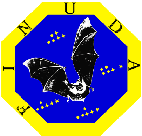

The FINUDA Online Monitoring
and Event Display System
The C++ classes developed for the FINUDA online monitor system
and their relationship are described in the following.
 The Global Run information, coming as a separate sub-buffer at the
beginning of each run, is organized into an object of the
TFndGenInfo class.
The Global Run information, coming as a separate sub-buffer at the
beginning of each run, is organized into an object of the
TFndGenInfo class.
 The Raw Data Tape events (RDT), written by the Global Event Builder (GEB)
process, are organized into a header (TFndHHdr class)
and a set of sub-event buffers, containing
the information coming from separate detectors. The sub-event takes two
different formats, corresponding to the gts, tof, lmd, stb
(TFndRawEqp class) and the
ism, osm detectors (TFndRawSil class),
respectively.
A TFndRawSlc class, describing the raw Slow Control buffer
slc, will be developed.
The Raw Data Tape events (RDT), written by the Global Event Builder (GEB)
process, are organized into a header (TFndHHdr class)
and a set of sub-event buffers, containing
the information coming from separate detectors. The sub-event takes two
different formats, corresponding to the gts, tof, lmd, stb
(TFndRawEqp class) and the
ism, osm detectors (TFndRawSil class),
respectively.
A TFndRawSlc class, describing the raw Slow Control buffer
slc, will be developed.
 The Raw Event contains the elementary information, still in encoded format.
In order to monitor the detector performance, to start the event
reconstruction and the event display, a re-organization of the RDT event
must take place, leading to a more flexible data format, which we call HDT
(Hit Data Tape), described by the TFndHdt class.
The Raw Event contains the elementary information, still in encoded format.
In order to monitor the detector performance, to start the event
reconstruction and the event display, a re-organization of the RDT event
must take place, leading to a more flexible data format, which we call HDT
(Hit Data Tape), described by the TFndHdt class.
 The HDT Event is a composite object, containing the Event Header
(TFndHHdr class), the Trigger
(TFndTrig), a set of integer values corresponding to the
multiplicities of each detector, and a list of hits for each detector
(TObjArray class). The elements of each list are described
by the TFndHTof, TFndHSil,
TFndHLmd, TFndHStb classes, corresponding
to the Time of Flight, Silicon Detector, Drift Chambers and Straw Tubes
elementary hits.
The HDT Event is a composite object, containing the Event Header
(TFndHHdr class), the Trigger
(TFndTrig), a set of integer values corresponding to the
multiplicities of each detector, and a list of hits for each detector
(TObjArray class). The elements of each list are described
by the TFndHTof, TFndHSil,
TFndHLmd, TFndHStb classes, corresponding
to the Time of Flight, Silicon Detector, Drift Chambers and Straw Tubes
elementary hits.
 The bridge from the Raw to the HDT Event is the information contained into the
Database, described by the TFndFeeMap class, which
allows the correct mapping of an electronic channel number to a well
identified detector channel (slab, strip, wire, tube).
The bridge from the Raw to the HDT Event is the information contained into the
Database, described by the TFndFeeMap class, which
allows the correct mapping of an electronic channel number to a well
identified detector channel (slab, strip, wire, tube).
 The Online Monitoring is provided by making use of ROOT shared memories,
in which a producer stores and periodically updates a set of histograms.
This task is performed, for different detectors, by the following set of
classes:
The Online Monitoring is provided by making use of ROOT shared memories,
in which a producer stores and periodically updates a set of histograms.
This task is performed, for different detectors, by the following set of
classes:
 The shared memories are read by a consumer, which runs interactively and
displays the histograms on operator request, through the ROOT Object Browser.
The shared memories are read by a consumer, which runs interactively and
displays the histograms on operator request, through the ROOT Object Browser.
 The Event Display is started by the creation of an object of the
TFndDisplay
class, from an interactive session. A clickable menu allows to access the
FIRST or LAST event on the HDT file, and then to move around the file with the
NEXT and PREVIOUS buttons.
The Event Display is started by the creation of an object of the
TFndDisplay
class, from an interactive session. A clickable menu allows to access the
FIRST or LAST event on the HDT file, and then to move around the file with the
NEXT and PREVIOUS buttons.
 The class allows either to scan a HDT file after an offline reconstruction or
to access a HDT file which is at the same time being produced by a process
receiving Raw Events from the GEB across the network, allowing to display
events in online mode.
The class allows either to scan a HDT file after an offline reconstruction or
to access a HDT file which is at the same time being produced by a process
receiving Raw Events from the GEB across the network, allowing to display
events in online mode.
 The operator can display a 2D Front, Side or Top
view of the experimental set-up or a 3D view.
On top of the experimental configuration, the hits are displayed, with
different colours, depending on whether they were used or not to fit a track
by the reconstruction code.
The operator can display a 2D Front, Side or Top
view of the experimental set-up or a 3D view.
On top of the experimental configuration, the hits are displayed, with
different colours, depending on whether they were used or not to fit a track
by the reconstruction code.
 The implementation of a class describing reconstructed tracks will soon
be added to the package.
The implementation of a class describing reconstructed tracks will soon
be added to the package.
Back to the
HREF="http://www.lnf.infn.it/esperimenti/finuda/finudasoftware.html">
FINUDA Software homepage
PC
(update 27 Jan 99)